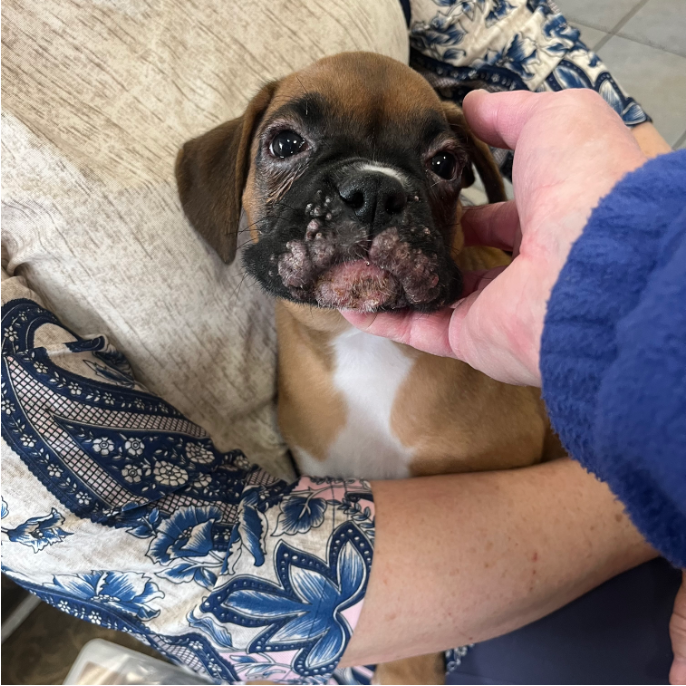Have you ever noticed bumps appear on the muzzle of a puppy along with other facial swelling? This could be a condition called puppy strangles also known as juvenile cellulitis. It is not a common disease and we do not understand why puppies suddenly start reacting in such a manner. It is thought that a small number of puppies have an extreme reaction to the normal bacteria on their skin, causing the regional lymph nodes to enlarge and lesions to develop on the muzzle, eyes and ears. Golden retrievers, Labrador retrievers, dachshunds, and Gordon setters are said to have a higher incidence but I have seen it occur in many other breeds. The key is to recognize and treat early before muzzle hair loss starts and the animal is miserable and off food.
Puppy Strangles Symptoms
Usually puppy strangles starts with lesions on the lips, eyelid swelling, followed by bumps appearing on the muzzle, lip swelling, inside the ear flaps and lastly the lymph nodes under the jaw swell. As it progresses, the puppy looks like it has mumps as lymph nodes swelling can be marked. That is also how this condition gets the name puppy strangles as it can push on the trachea, although puppies won’t actually strangle. It develops quickly between the ages of three weeks and four months of age with the first sign of marked swelling of the muzzle, eyelids, and face. Oftentimes, the owner thinks the puppy was bitten by a stinging insect or a spider.
Left untreated the lesions of the muzzle will rupture and ooze bloody serum. They are painful but not itchy as most reactions are. Twenty-five percent of puppies with this condition do not want to eat or do not eat well and act like it is sore to swallow. Puppies can be sore jointed and walking can be painful with puppy strangles but most are not.
With appropriate and early medical intervention, these pups will usually make a full recovery. Treatment includes an antibiotic good for skin (Clavamox or cephalexin), prednisone to manage the allergic component of this disease, and an astringent to reduce scarring of the skin.
Steroids are an essential component of treatment. However, many veterinarians are reluctant to add steroids as they are often thought of as being contraindicated when there is an infection.
How is Puppy Strangles Diagnosed?
Puppy strangles are diagnosed based on the skin lesions, enlarged lymph nodes under the neck, and age and breed of the pup(s). Many times, littermates are affected almost simultaneously.
Puppy Strangles Treatment
Since the heart of this issue is an immune reaction that is fighting the lymph tissue in the face and lymph nodes under the jaw, immune suppression is the key to treatment. You literally need to convince the body this lymph tissue is normal and should not be rejected by the immune system!
Veterinarians typically start with IV dexamethasone then send home oral prednisone tablets to complete therapy. The best treatment is high dose steroids to get the issue under control then taper those off. The dose is typically decreased by 25 percent after a response is seen and then decrease the dose weekly until stopped. If you stop treatment too early, the puppy will relapse. Steroids are a prescription item and your veterinarian can help you with the dose and weekly tapering dose. Antibiotics are not the answer but are often used if the bumps on the muzzle are open in a progressive case.

Is Puppy Strangles Contagious?
While puppy strangles are not contagious, you may see multiple pups in a litter affected. When puppy strangles does affect multiple pups, there appears to be a genetic component, thus littermates may be affected. It may be best not to breed a dog who was affected with strangles as a pup. If a litter was produced with strangles, you may want to avoid breeding that pair together again, and instead seek out a different mate. If a second litter is produced, removing the parent from the gene pool is indicated.
How Long Does it Take a Dog to Recover From Puppy Strangles?
Recognizing puppy strangles early is key to a quick cure. With early treatment, most puppies are normal by ten to fourteen days. Caught late or waiting and seeing usually results in a 21 to 30 day treatment course or longer and facial hair loss. Hair will grow back with time once treatment is completed.
If you have more questions on puppy strangles, call a Revival Animal Care Specialist at 800.786.4751.
LEARN MORE:
Skin Fold Pyoderma in Dogs and Cats
What is skin fold pyoderma? Skin fold pyoderma is a skin condition that affects dogs and cats that have a lot of wrinkles and facial folds. Learn the symptoms, treatment and prevention.
Treating Skin Conditions in Dogs and Cats
What can I put on my dogs irritated skin? How can I soothe my cat's itchy skin? Choosing the right product to treat your pet's skin conditions can be tricky. Learn cat and dog skin care tips and what products can easily treat common skin conditions.
Why Does My Dog Have Smelly Skin?
Do you find yourself saying "My dog's skin smells bad!"? Dr. Marty Greer talks about smelly dog skin and discusses some possible solutions.
How to Keep Your Pet’s Skin and Coat Healthy
How can I improve my dog's hair coat? Does my cat need skin care? Skin problems are a common reason why people bring their pets to the vet. Keep your pet's skin and coat healthy by following these easy steps.
Written by: Marty Greer, DVM
Director of Veterinary Services
Marty Greer, Doctor of Veterinary Medicine, has 40+ years’ experience in veterinary medicine, with special interests in canine reproduction and pediatrics. She received her Doctor of Veterinary Medicine from Iowa State University in 1981. She’s served as Revival’s Director of Veterinary Services since 2019. In 2023, Dr. Greer was named the Westminster Kennel Club Veterinarian of the Year.
